Intermediate Volatility Agent (IVA)
Volatility, or maximum vapor concentration (Cmax), is a characteristic of a substance that represents its ability to convert to a vapor state. The higher the volatility, the higher the rate of vaporization of the chemical warfare agent (CWA), and the faster the lethal vapor concentration of the agent is reached. Volatility is measured under laboratory conditions of a closed system when the substance and its vapor are in a state of equilibrium. In real field conditions, due to the influence of climatic and meteorological factors, the vapor concentration of the chemical agents is much lower than the laboratory values. Therefore, in achieving the maximum damaging effect, Cmax should be 10–100 times higher than the lethal concentration (LC) of the CWA[20].
Volatility is calculated by the formula:
where Cmax — maximal volatility (mg/m3), MW — molecular weight, VP — saturated vapor pressure (mm Hg or torr), T — temperature K° (°C+273.15)
As seen from the formula, volatility depends on the boiling point — the higher the boiling point of CWA, the lower its volatility. Also, volatility depends on molecular weight — with increase in molecular weight decreases the probability of obtaining volatile substances. Toxic volatile substances among compounds with molecular weight greater than 100–120 are not encountered[4].
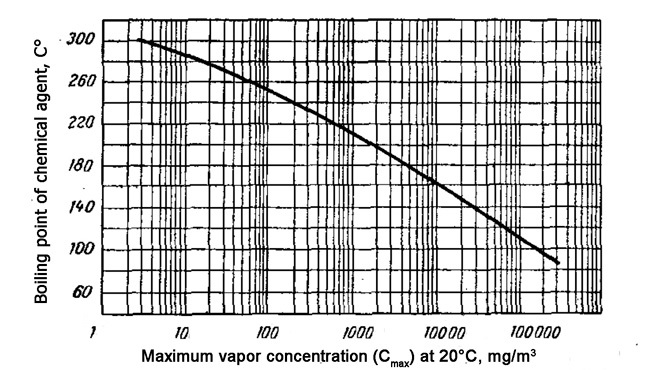
Relationship between boiling point and saturation concentration (taken with changes, S. Franke. Lehrbuch der Militärchemie, Band l, DDR. )
According to N. Antonov, among G-type chemical agents, the highest toxicity is found in substances with molecular weight 180–190, for V-gases — approximately 280[4].
Intermediate Volatility Agent (IVA) — organophosphorus chemical agents or their formulations with volatility higher than that of VX but lower than that of sarin. The idea of creating such types of chemical agents is quite old — in the U.S. work in this field has been carried out since 1954. In the Soviet Union in the '70s were synthesized highly toxic chemical agents in ordinary (A-230, A-232 and A-234) and binary (Novichok) versions, probably also belong to IVA. Major General N. S. Antonov (1994) in his monograph noted "that only those chemical agents can be promising, which are moderately volatile liquids capable of causing both inhalation and skin-resorptive lesions of people in submicrodoses. For this type of chemical warfare, the USSR and Western countries developed both conventional and binary chemical munitions"[4]. Almost all of the information on this subject is still classified, and the final result that was achieved is unknown.
From the '60s to the '90s, all the efforts of the world's major chemical weapons development centres have been directed towards finding a CWA with optimal volatility, capable of producing in a combat situation a concentration of CWA sufficient to kill a person in the time required to put on a gas mask, i.e. in 30–60 seconds[4], while its percutaneous toxicity should be at the level of VX. It was even suggested that the use of CWA with intermediate volatility would make it possible to dispense with sarin and VX. In later stages of the Russian and American programmes, binary systems were developed — in the USSR it was Novichok, in the USA the most likely candidates for IVA were considered to be: a mixture of sarin with 2-methylcyclosarin, binary thickened soman (EA 5774T) and GV-2.
| Persistency | Name | Molecular weight |
Boiling point (°C) | Volatility Cmax (mg/m3 25°C) |
Ref. |
|---|---|---|---|---|---|
| Non-persistent | Sarin (GB) | 140.1 | 157°C | 18 700 | [40,26] |
| Diisopropyl fluorophosphate (DFP) | 184.1 | 183°C | 8 000 | [66] | |
| Semi-persistent (IVA) | Soman (GD) | 182.2 | 198°C | 3 930 | [40,25] |
| Agent GP | 194.2 | 222°C | 984 | [56] | |
| GV-4 (EA 5414) | 212.2 | 224°C | 160 | [40] | |
| GV-11 (EA 5365) | 198.2 | 226°C | 530 | [64] | |
| ThioCyclosarin (EA 2223) | 196.2 | 227°C | 1220 | [64] | |
| Cyclosarin (GF) | 180.2 | 228°C | 898 | [40,25] | |
| O-Isopropyl Tabun (EA 4352) | 176.2 | 234°C | 548 | [40] | |
| 2-Methyl Cyclosarin (EA 1356) | 194.2 | 235°C | 508 | [40] | |
| Tabun (GA) | 162.1 | 245°C | 497 | [40] | |
| Persistent | Vx (Medemo) | 211.3 | 256°C | 76.4 | [25] |
| VM (Edemo) | 239.3 | 293°C | 40 | [45] | |
| VX | 267.4 | 292°C | 12.6 | [25] | |
| Russian VX (RVX) | 267.4 | 295°C | 9.06 | [28] | |
| Chinese VX (CVX) | 267.4 | 306°C | 3.55 | [22] |
Sarin, soman and VX are considered the most effective chemical warfare agents that have been or are now being weaponized by various countries. They differ in their physicochemical and toxicological properties and are designed for different combat missions. Sarin is highly volatile, VX evaporates slowly, and soman occupies an intermediate position and meets most of the requirements for an intermediate-volatile agent.
Impact of volatility on the military use of chemical warfare agents[29]
Percutaneous toxicity
The higher the volatility, the more rapidly the chemical will evaporate from the surface of the bare skin. Sarin is extremely toxic when inhaled, but it becomes much less toxic when it is applied to the skin. Under normal conditions, a drop of sarin evaporates from the surface of the skin within 2 minutes, during which time only 2% of the amount applied is absorbed into the body[3]. A dose of 40 mg of liquid VX applied to skin would kill if left for about 2 hours[67].
Penetration of chemical agents through clothing
The ability to defeat through clothing is even more important than percutaneous toxicity since the area of human skin protected by clothing is 10 times greater than the area of unprotected skin. In case of contact with uniforms, drops of CWA settle on fabrics and do not reach the surface of the body, and the skin of a person is affected by vapours of toxic substance formed in the underclothing space[4]. When VX comes into contact with the bare skin in the form of drops, its toxicity is several tens of times higher than that of soman. However, the more volatile soman penetrates much better through clothing and is almost as effective as VX[14].
Inhalation toxicity
Inhalation toxicity of sarin is extremely high — fatalities can occur after a few inhalations. VX, on the other hand, due to its low volatility, is not capable of causing rapid inhalation injury. However, the low volatility of VX has the advantage that it is much safer to produce and store than sarin. When, due to the Vietnam War, the VX production plant ran out of shell casings for artillery shells, VX was stored in the open air in 38-ton tanks without concern for safety[2].
Persistency
Sarin is a non-persistent chemical agent and is intended for offensive operations. Its persistence is less than 4 hours in summer.
VX is a persistent chemical agent, and contamination of the terrain in summer time lasts up to 3 weeks[20], after its use there are "chemical minefields", overcoming which is practically impossible without subsequent decontamination of equipment and uniforms.
Soman, tabun, cyclosarin and GV are classified as semi-persistent CWA. The persistence of soman on the ground is several days.
Decontamination
After exposure to sarin vapors, especially in hot weather, simple ventilation is sufficient to decontaminate clothing. VX and soman exposure will require a change of underwear and uniforms. Soman decontamination is a difficult task. Soman is well absorbed by clothing, rubber, wood, paintwork, and any absorbent surface from which it is virtually impossible to remove. According to Major General N. S. Antonov, there are no effective methods for the decontamination of soman[4].
Means of application
Sarin is most effective in vapor form, while VX is effective as a coarsely dispersed aerosol. The optimum VX droplet size depends on the height from which the chemical agent is dispersed: 0.12–0.15 mm when the projectile is detonated at low altitude and up to 0.4-0.6 mm when dispersed from a height of 800–1200 meters.
A thickener is added to VX and soman to prevent them from completely evaporating during the spraying[4]. Thickened chemical agents form large droplets on the surfaces of skin or uniforms, which vaporize longer and, due to longer contact time, have time to inflict more severe damage. In the USSR, ⅔ of all stocks of soman were in the thickened formulation of VR-55. Thickened RVX was produced in insignificant volumes and only to equip warheads of operational-tactical missiles R-17 (SCUD)[10].
Munitions design
Sarin is used primarily in impact detonator munitions for artillery and multiple rocket launchers (MLRS). On contact with the target, the projectile explodes to produce vapors or a fine-dispersed aerosol.
Soman and VX are used for ammunition with remote fuses and, predominantly, larger volumes — in the USSR, these were aerial bombs, air spray tanks (VAPs), and warheads of tactical and strategic missiles[10].
Strategy of application
Volatile CWAs are planned to be used for sudden destroying of enemy combat units. In this case, lethal or disabling concentrations must be reached within a few minutes before the gas mask is put on. Sarin is used in areas where their own or allied troops are expected to attack in the near future.
Substance VX is designed to permanently contaminate terrain far from the battle line in order to restrict or prevent the movement of enemy troops[20].
Soman, due to the lack of effective means of decontamination and treatment of poisoning, is also intended to contaminate territories where the introduction of its own troops is not planned[4].
History of research on CWAs with intermediate volatility (IVA)
After the First World War, a popular doctrine was that it was sufficient to have only two types of chemical agents in armament: one non-persistent and volatile for offensive use, the other persistent and non-volatile for long-term contamination of the enemy territory. Having launched industrial production of sarin and then VX, the United States decided that the problem of two chemical agents was solved and abandoned the production of other chemical agents, focusing on the development of binary munitions with sarin and VX. The British War Office, too, had a "definite aversion to persistence" and refused to continue research on cyclosarin and soman[43].
Proving more prescient than their American counterparts, Soviet chemical weapons developers began producing soman in 1967, in addition to sarin and Soviet V-gas.
In the USA, they tried to increase the volatility of CWA by mixing two chemical agents — volatile Sarin and non-volatile VX, however, there were difficulties with the means of delivery of such a formulation — sarin vaporized when the projectile was detonated at altitude, and it was impossible to disperse VX in the form of droplets when it burst on the ground[4]. Iraqi chemists were more successful in creating such formulations, even in binary formulations. The Iraqi binary bomb R-400 was equipped with components to produce a mixture of sarin (GB) and cyclosarin (GF). Due to slower evaporation, this formulation was more persistent in hot southern climates[12]. In the 80’s and 90’s, the US probably returned to the idea of using two chemical warfare agents. Leading chemical engineer at Edgewood Arsenal S. R. Eckhaus, mentioned in an interview that the final IVA was a mixture of sarin and 2-methyl cyclosarin (EA 1356)[1].
| Chemical Agent | Volatility Cmax (mg/m3 25°C) |
Inhalation Toxicity LC50 (mg·min/m3) |
Percutaneous Toxicity Liquid, LD50 (mg for 70-kg man) |
Ref. |
|---|---|---|---|---|
| Sarin (GB) | 18 700 | 35 | 1000 | [26,30] |
| Soman (GD) | 3930 | 35 | 350 | [25,30] |
| ThioCyclosarin (EA 2223) | 1243 | 100 | 180 | [40] |
| Cyclosarin (GF) | 898 | 35 | 350 | [25,30] |
| GV (EA 5365) | 530 | 40 | — | [29,32] |
| 2-Methyl Cyclosarin (EA 1356) | 508 | 70 | 170 | [40] |
| Tabun (GA) | 497 | 70 | 1 500 | [25,30] |
| CyclobutylSarin | 300* | — | 24 | [58] |
| VX | 12.6 | 15 | 10 | [27,30] |
| RVX (Russian VX) | 9.06 | 40 | — | [28,33] |
Progress in binary CWAs has allowed for a rethinking of toxic substances previously rejected because of chemical instability and problems with storage — GV-type substances, methylfluorothiophosphonates and their azides, Tammelin esters and other toxic substances eligible for IVA.
I. First generation of CWAs (DFP, Tabun and its homologs)
The first generation of organophosphorus CWAs usually includes diisopropyl fluorophosphate (DFP) octamethylpyrophosphoramide (OMPA), tetraethyl pyrophosphate (TEPP) and Dimefox. These nerve agents were studied in Great Britain during World War II as a replacement for hydrocyanic acid, a highly problematic chemical agent with many drawbacks. However, hydrogen cyanide has an important advantage over the other old CWAs — mustard gas and phosgene. Because of its high volatility, lethal concentrations of hydrogen cyanide were reached so quickly that death could occur after only a few breaths. Experiments with DFP on volunteers looked encouraging, but field trials have shown that despite relatively high volatility, it is not possible to rapidly create lethal concentrations of DFP in open areas. In addition, after the end of the war, it turned out that DFP, Dimefox and other similar British "quick-kill" chemical agents were far inferior in effectiveness to German tabun, which, by the end of the war, was produced in Germany on an industrial scale. Although tabun is considered a G-type chemical agent, it is chemically more similar to Dimefox than sarin and soman.
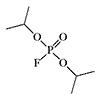 |
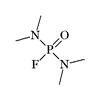 |
 |
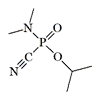 |
| DFP *Cmax — 2117 mg/m3[7] |
Dimefox Cmax — 940 mg/m3[40] |
Tabun (GA) Cmax — 497 mg/m3 |
EA 4352 Cmax — 520 mg/m3 |
The US and USSR abandoned the production of tabun in favor of the more toxic sarin and soman, and trophy stocks of German tabun were destroyed. However, many countries continued to develop their own production of tabun. In France, a pilot plant produced 20 tons of tabun between 1950 and 1952. About 140 tons of tabun were used by the Iraqi army during the Iran-Iraq war[1].
In the early '70s, however, there was a resurgence of interest in tabun at Edgewood Arsenal[2]. Tabun, considered an obsolete CWA, proved more persistent on the ground than fast-evaporating sarin, and tabun's inhalation toxicity was only slightly less. While sarin was used primarily in artillery shells, for attacks close to the battle line, tabun was better suited for use by longer-range multiple rocket launchers (MLRS), blocking enemy advancement for hours to days, until own troops reached the site of a chemical attack. In the '70s, the US Army was more and more inclined to switch to binary systems, but no suitable binary reaction could be found for tabun, and its dermal toxicity, compared to the more modern VX, was no longer relevant[1].
More suitable for IVA is the isopropyl homologue of tabun (EA 4352). It is nearly as toxic as sarin and has the same volatility[40]. It is very likely that the USSR and the USA developed CWAs from the tabun group with even more favorable characteristics.
II. Second generation CWAs (G-type) and their thioanalogs
In the mid-'40s, the U.S. Chemical Corps was faced with the difficult choice of which of the G-gases to favor and begin industrial production. The most likely candidates were sarin (GB), soman (GD), ethylsarin (GE), cyclosarin (GF), and isopentylsarin (GH). Soman (GD) was considered to be the most suitable in terms of physicochemical and toxicological characteristics. But its industrial production was too dangerous due to the lack of an effective antidote, and the cost of the precursor — pinacolin alcohol — was high, as it was not produced on an industrial scale and the technological process would have to be developed from scratch. As a result, soman was rejected in favor of sarin, which was synthesized using cheap and readily available isopropyl alcohol.
The USSR was not intimidated by the high cost of soman, not the dangerous manufacturing. And soman lived up to expectations — "formula VR-55 or thickened soman, before obtaining of VX, was regarded as the basic means of inflicting injuries on live enemy target by acting on skin around gas mask"[4]. Chinese authors assumed that in the 70’s the USA also decided to return to the weaponization of soman, but already in binary version, and the American CWA with intermediate volatility under the code IVA is nothing but thickened soman (EA 5774)[1].
 |
 |
 |
 |
 |
| Soman (GD, EA 1210) Binary — EA 5774 |
Cyclosarin (GF, EA 1212) | EA 1356 Binary — EA 5824 |
Substance GP | Cyclobutylsarin |
Besides soman, two other chemical agents may be of interest as IVA candidates, these are cyclosarin (GF) and its 2-methyl homolog EA 1356, both of which are superior to sarin in terms of dermal toxicity[4]. EA 1356 is one that was first studied by the Chemical Corps in the late '40s or early '50s. Bench-scale synthesis and filling operations of EA 1356 and its isomer EA 3534 were carried out until 1985 in a Pilot Plant Complex at the Aberdeen Proving Ground, Maryland[42].
Iraq was also looking for ways to improve the persistence of its organophosphorus chemical agents of the sarin group. In addition to producing unitary and binary chemical munitions with a mixture of sarin (GB) and cyclosarin (GF), other G-gases were being researched: ethylsarin (GE), n-butylsarin, iso-butylsarin, and thiosarin[12].

Iraqi DB-2 aerial bomb filled with a mixture of sarin and cyclosarin (GB/GF)
Among cyclic analogs of G-gases, the substance GP is considered a perspective candidate for IVA. Its volatility is four times lower than that of soman[56], and its toxicity is one and a half times higher[57]. However, the production of its precursor is even more complicated and expensive than pinacolin alcohol for soman.
Methylphosphonofluoridothioates. In the USA, the first person to become interested in this group of chemical agents was the former German chemist Friedrich Hoffmann[31]. After the end of World War II, thanks to the secret British program Operation Matchbox, he and other German scientists were transferred to the UK. At the Military Chemical Research Center in Porton Down, he continued the work on organophosphorus chemical agents that he had begun in Germany. In 1947 F. Hoffmann moved to the United States, where in Edgewood Arsenal he worked on the preparation of new types of chemical agents, such as systox derivatives, phosphonofluordothioates and their azides, binary VX . Later, in the '50s such a valuable specialist was interested in the CIA, where he is involved in the study of LSD, cannabinoids and various diversion poisons[38].
 |
 |
 |
 |
 |
| EA 2223 (ThioGF) Cmax — 1 243 mg/m3 |
EA 2261 Cmax — 750 mg/m3 |
EA 2337 (ThioSoman) Cmax — 6 900 mg/m3 |
EA 2361 Cmax — 2 900 mg/m3 |
EA 5389 Cmax — 520 mg/m3 |
The well-known (in narrow circles) British military chemist Arthur H. Ford-Moore (1896–1958), who worked in Porton Down Laboratory, did not ignore this group of chemical agents. In the '50s he investigated all possible ether modifications of chemical agents such as sarin and decided to broaden his search.
The esters of methylphosphonofluoridothioic acid boil at a lower temperature than the corresponding G-type chemical warfare agents, and some of them smoke in air due to their high vapor pressure. Reaction between methylphosphonothioic difluoride and alcohol proceeded exothermically and rapidly, potentially enabling the development of binary chemical weapons[32].
Since the American data were declassified only in 1977, in the Chemical Laboratory of the National Defense Research Organization (Netherlands) in 1966, independently of the American researchers, were synthesized thiosarin, thiosomane, substances corresponding to the American EA 2233, EA 2361 and others[33].
In the 80’s, Iraq successfully mastered the methodology for the synthesis of thiosarin and Tammelin esters. The United Nations Monitoring, Verification and Inspection Commission (UNMOVIC) decided at the time that the work was of no practical significance because thiosarin was believed to be less toxic than sarin[34].
Methylphosphonofluoridothioates are very rarely mentioned in open sources of information, and data on the toxicity of this class of chemical agents are not available. Soman and thiosoman have similar half-inhibition concentrations (pI50), but this does not guarantee that the toxicity of thiosomane to mammals will be as high. D. H. Ellison for the thioanalogue of cyclosarin (EA 2223) indicates a median lethal concentration (LC50) of 100 мг·мин/м3, which is only 1.5–3 times higher than that of cyclosarin. Hydrolysis of EA 2223 produces cyclosarin[40].
In the USSR, several publications on the synthesis and structure of O-alkyl esters of methylphosphonofluoridothioic acid were published in 1968–1975[35]. In the early '80s, the GosNIIOKhT (State Scientific Research Institute of Organic Chemistry and Technology) became interested again. There, under the direction of E. Bogomazov, work was carried out to study thiono analogs of soman and sarin, which “behind a gas mask filter transformed into their oxygen analogs — chemical warfare agents”. These works first became known thanks to a former GosNIIOKhT employee, Vil Mirzayanov, who immigrated to the United States and published a book about the secret Soviet chemical program. Here is what Mirzayanov, who directly participated in this program, writes about it:
"Very soon, Bogomazov and two of his junior colleagues, Dmitri Zalepugin and Aleksander Dmitriev, made a discovery that all the military chemists of the world could only dream of.
They discovered that the thionic analogs of soman and sarin, CH3P=S(F)–OR, where R is the alcoxy radical – could break through an army gas-mask filter. Then these compounds, which have a comparatively low toxicity, would turn back into their oxygen analogs, CH3P=O(F)–OR (chemical agents) once they had passed through the filter".
Soon they discovered that the selenium analogs of soman and sarin, synthesized by Dr. Evgeni Greenshtein’s group, could also break through the gas-mask filter. It looked like we would soon be able to meet the demand of the Directorate of the Chief of the Chemical Troops (UNKhV) to reduce the initial concentrations of aerosolized chemical agents to less than a few hundredths of a milligram per liter of air. For some reason the military authorities were stuck on the idea that this concentration of chemical agents would be economically “efficient” for killing soldiers on the battlefield, and those in the command stations and gas-protection chambers[36].
The new CWAs had a serious disadvantage, they were self-flammable on contact with air, but this problem was solved by the addition of a special additive[36].
В. Mirzayanov claims that the data obtained by Bogomazov's group contained a fundamental error and that there was no breakthrough in gas masks. However, the Russian "List of chemicals and precursors that can be used in the production of chemical weapons" (2017) includes 52 fluorothiophosphonates[37].
III. Third-generation CWAs (V-type)
All three V-gases, American, Soviet and Chinese, are isomers and have similar physical and chemical characteristics — they are oily liquids, colorless and odorless, boiling at high temperature and have low vapor pressure. The volatility EA 3148, of the V-agent new generation (the most potent nerve agent administered to volunteers)[60] was even lower than that of VX[40]. This substance was studied in the USSR and the USA as a possible replacement for VX and RVX, but was eventually rejected[15].
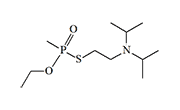 |
 |
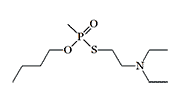 |
| American VX Cmax — 12.6 mg/m3[25] |
Russian VX (RVX) Cmax — 9.06 mg/m3[28] |
Chinese VX (CVX) Cmax — 3.55 mg/m3[22] |
But, among V-type chemical agents, there are substances with higher volatility, of which MEDEMO is the most studied. Its volatility is approximately 6 times higher than that of VX[25]. This substance, known under various codes, has been studied in France, Italy, Sweden (33 SN, F-gas), Czechoslovakia, Yugoslavia (medemo-3), Romania (Vx) and the USA (EA 1699)[6].
According to declassified documents, U.S. intelligence believed MEDEMO was Soviet V-gas (RVX)[52], and when in 1993 Russian ecologist Lev Fedorov published the formula of the real RVX in the journal "Chemistry and Life"[53], it was a complete surprise for the Americans[54]. In addition, public documents referred to Soviet V-gas by the code Vx, which added to the confusion[55].
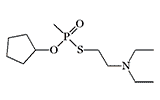 |
 |
 |
| EA 3148 (Substance 100-A) Cmax — 5.72 mg/m3[40] |
MEDEMO (Vx) Cmax — 76.4 mg/m3[25] |
EDEMO (VM) Cmax — 40 mg/m3[45] |
The diethylamine homologue EDEMO (according to the American classification VM or EA 1664) has slightly lower volatility — 40 mg/m3[45]. The pilot production of EDEMO may likely have been under development in the USA[9]. In Syria, the nerve agent VM was stockpiled in binary form until 2013, when it was destroyed[44].
IV. Fourth generation CWAs (GV- and A-series)
GV-type agent. The chemical agent EA 5365 was probably first obtained in the United States in the late '60s[5] and was re-synthesized in 1983 by Czech chemist Ivan Mašek from the Military Research Institute 070 in Brno[60]. The structural formula of EA 5365 has similarities with both G- and V-type substances, therefore in the countries of the socialist bloc this substance was designated by the code GV (but sometimes GP is also used). In 1992, Czech researchers published toxicological characteristics of a new chemical agent, which was similar to VX in inhalation toxicity and 4 times more toxic than soman when applied to the skin[62]. However, substance GV had a significant disadvantage — it degraded rapidly and required freezing for storage in the laboratory, so it can only be used in a binary version[13]. The volatility of GV was at the level of its main competitor, 2-methylcyclohexyl methylphosphonofluoridate (EA 1356)[29].
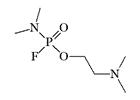 |
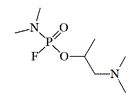 |
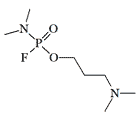 |
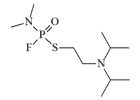 |
| GV, EA 5365 Binary — IVA-2 |
EA 5403 | EA 5414 | EA 5488 |
After the closure of the chemical weapons program, the U.S. did not declare any binary GV precursors in storage. Likely, the leak of information about the formula of the GV substance was part of a U.S. counterintelligence program known as Operation Shocker. A double agent working for the FBI gave Soviet intelligence the formula for the chemical substance GJ, similar in properties to GV.
And it, indeed, was a very deadly nerve gas developed in the labs at Edgewood. But American scientists had found it to be unstable and couldn't be weaponized, could not be stored in a weapon because it would lose its toxicity. It was very volatile. It wouldn't stay useful as a deadly nerve gas.
David Wise, author, “Cassidy's Run: The Secret Spy War Over Nerve Gas”[63].
Other known homologs (EA 5414, EA 5511) are less toxic than GV[40]. More attractive properties has quinuclidinol analog GV — substance EA 5488, its toxicity is about 2 times less, and volatility is 4.5 times higher than that of VX[40]. EA 5488 shares a common precursor with incapacitant BZ, 3-quinuclidinol, the technology for obtaining which has already been developed in the USA.
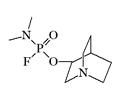 |
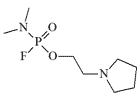 |
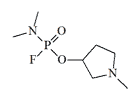 |
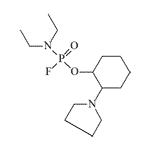 |
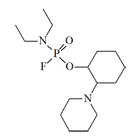 |
| EA 5488 | EA 5502 | EA 5511 | Cyclic analogs of GV synthesized at GosNIIOKhT | |
In GosNIIOKhT (State Scientific Research Institute of Organic Chemistry and Technology), cyclic analogs of GV have also been investigated, some of which are potent and highly selective inhibitors of butyrylcholinesterase[39]. Like the US experimental chemical agents EA 5488, EA 5502, and EA 5511, these compounds have an choline fragment
A-series agent. In 1972–1976 in GosNIIOKhT, were synthesized organophosphorus chemical agents of a new type — A-230, A-232 and A-234. However, because of the extremely high toxicity and "difficult to treat" poisonings, industrial production of new chemical agents was too complicated and dangerous. This problem was solved by developing binary systems based on them, called Novichok-5 and Novichok-7.
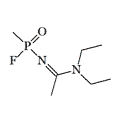
A-230 |
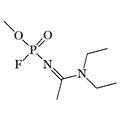
A-232 |
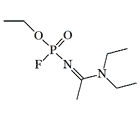
A-234 |
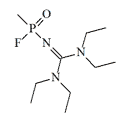
A-242 |
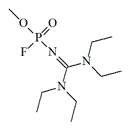
A-262 |
Employees of GosNIIOKhT, who participated in the development of this group of chemical agents, confirm the assumption that they can be attributed to CWAs with intermediate volatility.
And these substances, A-230, A-232 and A-234, have the combined properties of both soman (high volatility) and VX (high skin penetration)
V. Uglev — senior researcher at GosNIIOKhT, who discovered substances A-232 and A-234[51].
The agent A-232 has the same toxicity as Substance 33 (RVX), though it is much more volatile than Substance 33 and agent A-230[15]. Novichok-7 is approximately ten times more effective than soman but has similar volatility[8].
Vil Mirzayanov — head of the Department for Foreign Technical Counterintelligence in GosNIIOKhT
The results of theoretical calculations of saturated vapor pressure obtained by Carlsen L. (2019) also confirm that some A-series substances may have volatilities one or two orders of magnitude higher than Soviet or American V-gases.[21], Even taking into account the methodological inaccuracy (calculated volatility of VX and RVX is underestimated by a factor of 2.5), it is still possible to classify A-230, A-232 and A-234 as CWAs with intermediate volatility. Combining high inhalation and percutaneous toxicity, with a toxicity level comparable to VX, the new CWAs are 5-8 times more effective in combat.[8].
Predicted Volatility of Chemical Warfare Agents of the A- and V- Series(Carlsen L., 2019)[21]
| Chemical Agent | Estimated Vapor Pressure (mm Hg) |
Estimated Volatility Cmax (mg/m3) |
Relative Volatility (VX=1 ) more→higher |
|---|---|---|---|
| VX | 0,000352 | 5,04 (12,6) | 1 |
| RVX | 0,00026 | 3,73 (9,06) | 0,74 |
| A-230 | 0,05 | 520 | 103 |
| A-232 | 0,0407 | 460 | 91 |
| A-234 | 0,014 | 168 | 33 |
| A-242 | 0,00115 | 15,5 | 3 |
| A-262 | 0,000925 | 13,2 | 2,62 |
Chemical agents A-242 and A-262 are both known to be solids with very low saturated vapor pressures, which is also confirmed by theoretical calculations.